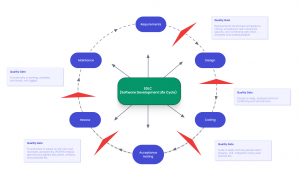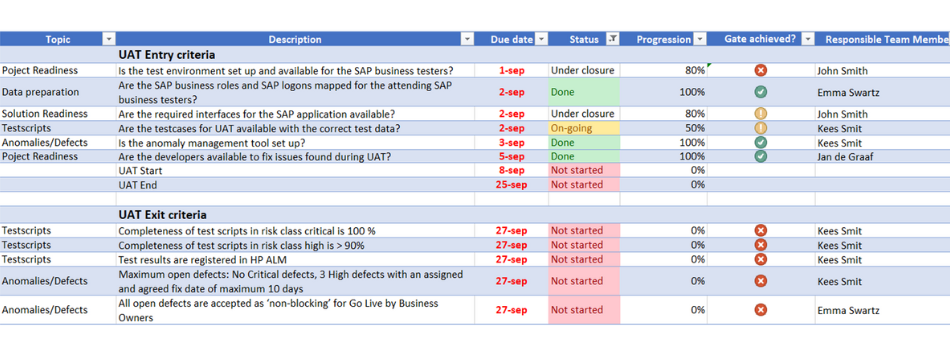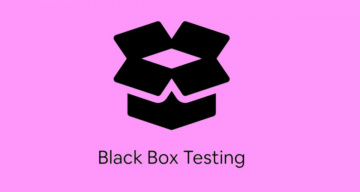On any project where teams utilize the Agile methodology in software development, specific metrics are essential for measuring product compliance with quality standards. They can be used at the code level—referring to entry and exit criteria in the software testing lifecycle or the concept of the Definition of Done (Agile Alliance). Additionally, there are criteria applied at the project level—these are quality gates.
What are Quality Gates?
Quality gates are benchmarks that verify the achievement of all goals in software projects. These are important quality management tools, which are checklists compiled even at the planning stage. They contain a set of criteria that the software solution must meet in order to move on to a new milestone in its development. Additionally, setting quality gates ensures that the final digital product will meet the needs of end users.

Such checklists are used to manage the stages of the SDLC (Software Development Life Cycle) and code quality at each stage. Typically, they are created by project managers or tech leads and discussed at meetings involving all team members.
- Requirements: During the requirements setting stage, it is important to ensure that they are understandable to all team members, unambiguous, consistent with each other, complete, and necessary for users.
- Design: Quality criteria should include compliance with selected tools, frameworks, and project goal during the design stage. Additionally, the design of the digital solution should be understandable, implementable, unambiguous, and available for testing.
- Coding: At this stage, it is essential to control code quality, code coverage, security rating on new code, and other characteristics of the codebase.
- Acceptance testing: This is the next stage of the SDLC, which involves quality gates for transitioning to the release of the digital product. Automation testing, access to the build in the repository, release date consistency, etc., are monitored.
- Release: After the software solution is released to the market, it is crucial to ensure that all implemented features work correctly. For this purpose, feature testing on production, application performance monitoring, logs monitoring, etc., may be conducted.
Compliance checks are carried out after completing each of the aforementioned development stages. They can have several outcomes:
- ✅ Pass: The results meet the established requirements, and the project can proceed to the next stage of software development.
- 🟡 Warn: Quality gates are not fully met, so you must make some adjustments before continuing work on the project.
- 🔴 Fail: Before you proceed to production, quality or security issues must be addressed.
Such checklists allow Project Managers (PM) to continuously monitor the development process and thereby contribute to its acceleration and the enhancement of the quality of the final product.
Importance of Conception
The quality gates conception provides teams with certain advantages that contribute to improving the results of the entire project. Among them, the following can be highlighted:
- Adherence to quality standards: By using quality gates, the entire team adheres to unified requirements for code quality and applies consistent styles and programming methods.
- Automation of reporting: Quality gates facilitate the creation of automatic reports containing key points regarding code quality.
- Optimization of workflows: By applying quality gates to the project, team members know what to check at the end of each stage of the software development lifecycle. This relieves them of routine tasks and allows them to focus on more complex development aspects.
- Enhancement of software product performance: High code quality increases the likelihood that the software will function properly after deployment. This is facilitated by tracking criteria such as CPU load, error and success rates, etc.
Quality Gates & SAP
Installing quality gates plays an essential role in SAP testing. Their use allows for full project control, making adjustments as needed, and ensuring high system quality.
In the official SAP community documentation, quality gates are considered stages in an IT project that requires adherence to pre-established criteria to progress to the next testing stage.
In SAP testing, checklists, which are Q-gates, can be used during or at the end of a specific testing stage, for example, during the transition of an SAP project from functional tests to UAT. In this case, the checklist will consist of UAT entry criteria and UAT exit criteria.

Let’s provide examples of criteria that may be included in such a checklist:
- Are SAP testers assigned?
- Do business roles match SAP tester accounts?
- Is the test environment configured and accessible to SAP testers?
- Are correct test data entered into the test environment?
- Are test scenarios created for User Acceptance Testing?
- Is there access to all necessary interfaces for the SAP application?
- Is all the necessary equipment prepared?
In the SAP project, the development of quality gates is managed by the testing manager. It’s important that checklists are prepared strictly at the end of one testing stage and the beginning of the next. If there’s a delay for any reason, the manager needs to discuss the situation with all stakeholders:
- Inform about the postponement of the start of a new testing stage or project completion dates.
- Compile a list of actions needed to start the next testing stage.
- Set new deadlines for transitioning the project to the next stage and schedule all necessary actions.
- Verify the availability of resources to achieve quality gates.
In addition to allowing SAP testers to clearly determine if the project is ready to move to the next stage, this method has other advantages:
- Clear understanding of the requirements that the software solution must meet. This is achieved because all stakeholders create checklists before the start of a new testing stage.
- Monitoring the progress of testing. Meetings can be held before starting a new stage to discuss compliance with established requirements and deadlines.
- Reduction of project work time. This is facilitated by the fact that the client must plan their system requirements in advance, and the testing manager determines what to test and how.
Implementing Quality Gates
You should carry out the implementation of quality gates step by step:
- Perform static code analysis – start by eliminating common errors and fixing security issues.
- Conduct a pilot launch with a small number of criteria to assess the effectiveness of your quality gates.
- Integrate quality gates into the development pipeline.
- Analyze all project components and make adjustments based on the results of the pilot launch.
- Create an implementation plan based on the results of the analysis.
- Expand the pilot project to the entire team using a dashboard with metrics and analytics.
- Complete the implementation by reanalyzing the work results.
Metrics
Q-gates metrics are conditions that must be met to start a new stage of work on the project. Here are some examples of metrics. Note that all of them must be measured, so it’s necessary to specify not only the metric itself but also its threshold value. Additionally, metrics are usually defined for both new and overall code.
Metrics for new code
| Metric | Operator | Value |
| Condition Coverage | is less than | 3 % |
| Duplicated Blocks | is greater than | 4 |
| Blocker Issues | is greater than | 5 |
| Bugs | is greater than | 10 |
| Vulnerabilities | is greater than | 7 |
| Security Review Rating | is worse than | B |
Metrics for overall code
| Metric | Operator | Value |
| Coverage | is less than | 30% |
| Duplicated Lines | is greater than | 40 |
| Effort to Reach Maintainability Rating A | is greater than | 35 min |
| Functions | is greater than | 45 |
| Lines of Code | is greater than | 55 |
| Reliability Rating | is worse than | A |
It’s important to align metrics with business objectives and user expectations to ensure that quality gates serve their purpose.
Relation of Acceptance Criteria and Quality Gates
Quality gates and acceptance criteria are two concepts used to control quality in Agile development. Acceptance criteria are the conditions that must be met to fulfill a specific user story.
Quality gates can be seen as a set of acceptance criteria used to check software quality before moving to the next stage of the development process.
Challenges Faced
Despite all the benefits of implementing quality gates, teams may encounter certain challenges in working with them:
- Resource Intensiveness: Comprehensive quality management, which involves thoroughly checking software quality at all stages of development, requires time, expertise, and other resources.
- Resistance to Innovation: If not handled properly, the team may perceive the implementation of quality gates as an additional burden.
- Requirement for Additional Skills: This is primarily true for complex projects with multiple dependencies. In such situations, managing quality gates may require additional knowledge and skills from specialists.
- Subjectivity: Sometimes, Q-gates may be incorrectly interpreted or evaluated insufficiently objectively.
To avoid the above-mentioned pitfalls, it is necessary to work on improving communication between stakeholders and training specialists involved in managing quality gates. We have compiled some recommendations for you to start working in this direction as effectively as possible.
Best Practices for Implementing Quality Gates
To ensure effective control of software quality, it is necessary to carefully plan the process of implementing quality gates and follow some recommendations:
- Involve all stakeholders: To know what to test and what result will qualify as “quality gates passed,” all stakeholders should participate in defining quality criteria.
- Gradually increase the number of criteria: To smoothly implement Q-gates for the team, start with a small number of criteria and gradually expand the list.
- Invest in QA automation: Specialized test automation tools allow for objective evaluation of deliverables and reduce manual efforts in quality control. This will increase development speed and improve the quality of the software product.
- Monitor the relevance of quality gates: All criteria should align with changing project goals and requirements, so it’s essential to continuously update and review them.
- Foster continuous learning for specialists: This goes beyond attending training sessions and webinars; it’s also important to facilitate knowledge sharing within the team.
Such an approach is the key to ensuring that the use of quality gates enables the organization to achieve its goals. We’ll discuss these goals further.
Outcomes Achieved with Quality Gates
Controlling software quality using Q-gates allows teams to achieve the following results:
- Budget savings: Issues on the project, including blocker issues, quality, and security issues, are identified in the early stages of development. This enables timely resolution, avoiding additional costs and negative user reactions.
- Improved quality of software products: Teams make informed decisions regarding all adjustments to the project. Thus, the digital solution fully meets the client’s requirements and target audience. This is possible thanks to comprehensive control at all stages of work.
- Accelerated release: Resolving errors in the early stages of project work, using automation tools, and constant progress tracking all enable developers to deliver the final product to the market faster.
- Increased customer satisfaction: Collaborative writing of criteria and discussion of work results in regular meetings make the development process transparent. This increases satisfaction among all stakeholders.
Bottom Line
Quality gates are a powerful quality management tool that ensures compliance with project quality standards and user expectations. With their help, teams can improve the quality of the software product, accelerate its release, and enhance stakeholder interaction. All of this contributes to the project’s success and the success of the entire organization.
😃 Still have questions? Contact Us, and we will answer all questions related to effective software testing.







